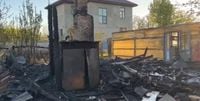In the latest developments from the Kharkiv region, law enforcement has reported a grim tally of 17 war crimes over the past day, highlighting the ongoing violence amid a supposed truce declared by Russian President Vladimir Putin. On April 20, 2025, Russian forces unleashed a barrage of artillery, including multiple launch rocket systems (MLRS), guided bombs, and kamikaze drones, targeting the Kupiansk and Chuhuiv districts.
According to the Kharkiv Regional Police, the strikes resulted in significant devastation, with more than 30 apartments in a multi-story building, a private home, a garage, and a vehicle set ablaze in Kupiansk. The local authorities are currently conducting evacuations from the settlements that are under constant shelling, urging residents to contact emergency services if they wish to leave these dangerous areas.
Oleg Sinegubov, the head of the Kharkiv Regional Military Administration, confirmed that the situation remains perilous, with ongoing violations of the ceasefire. He stated, "Six out of eight communities were under constant shelling over the past day," underscoring the precarious conditions faced by residents. The violence has also led to injuries; reports indicate that a 70-year-old woman was hospitalized due to the shelling.
In a separate incident, two foresters were injured when their vehicle detonated while responding to a large forest fire near Balakleya, where flames have consumed approximately 290 hectares of forest floor and 20 hectares of reeds since April 16. The fire has posed additional challenges for emergency responders already stretched thin by the ongoing conflict.
Despite the declaration of a truce, reports from the ground suggest that hostilities have not ceased. Andrey Kanashevich, the head of the local military administration, noted that while the night of April 19 was relatively quiet, the morning of April 20 saw an uptick in Russian shelling and drone activity. "We can say that the night passed more or less calmly, but the enemy continued to maintain a high level of danger, using aviation and guided bombs against Kupiansk and nearby settlements," he explained.
President Zelenskyy echoed these concerns, stating that after 10:00 AM, there was a noticeable increase in Russian attacks, including the use of FPV drones. He reported that from midnight to noon on April 20, there were already 26 assault actions by Russian forces, indicating that the situation remains volatile. "The Russian army is attempting to create the impression of a ceasefire, but the reality tells a different story," he remarked.
As the conflict continues, local authorities are working tirelessly to manage the fallout from the violence. Sinegubov reported that in the previous days, strikes on Kharkiv resulted in approximately 120 injuries, with one fatality and several individuals, including children, still hospitalized. The ongoing forest fire near Balakleya has further complicated the region's response to the crisis.
In light of these events, the Ukrainian military has reported that while no active offensive actions were conducted by Russian forces in the Kharkiv and Kupiansk directions on April 20, there were still 45 recorded clashes. The General Staff noted that the enemy continues to apply pressure with heavy weaponry in various fronts, particularly in the Donbas region.
As the situation develops, the local community is facing immense challenges. The emergency services are working hard to extinguish the forest fire and provide assistance to those affected by the shelling. The firefighting efforts have been ongoing, and the scale of the disaster has drawn significant attention from local and national authorities.
In a moment of solidarity, the National Guard brigade "Chartia" has initiated a project dubbed "Paskadron," delivering traditional Easter cakes to Ukrainian defenders in the frontline areas. This initiative aims to lift the spirits of the troops during these challenging times, showcasing the resilience and unity of the Ukrainian people.
As the people of Kharkiv navigate through this tumultuous period, their plight underscores the broader conflict that continues to ravage Ukraine. The resilience of the local community, coupled with the ongoing support from emergency services and military personnel, highlights the enduring spirit of those affected by the violence.
In conclusion, the situation in the Kharkiv region remains critical as residents grapple with the consequences of ongoing hostilities and natural disasters. The reports of war crimes, injuries, and destruction paint a stark picture of life in a conflict zone, while the efforts of local authorities and community members reflect a determination to persevere in the face of adversity.






